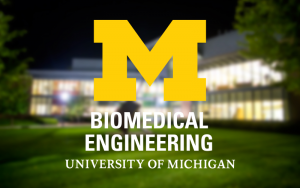Presented By: Biomedical Engineering
Ph.D Defense: James R. Day
ngineering an Immuno-Isolating Hydrogel-Based Capsule to Restore Ovarian Endocrine Function

Cancer patient survivorship has increased substantially over the past few decades due to advances in anticancer treatments. However, a common deleterious effect of these lifesaving treatments is premature ovarian insufficiency (POI), as they are gonadotoxic. POI leads to infertility and loss of ovarian endocrine function, which is particularly devastating for female cancer survivors who experience POI prior to puberty, as puberty is the most crucial physiological event in a female’s life. Lack of ovarian endocrine function and absence of puberty leads to long-term co-morbidities such as poor bone health, diminished metabolic turnover, impacted cognition, and high risk of cardiovascular events. Current treatment options such as hormone replacement therapy and ovarian auto-transplantation are associated with non-physiological delivery of hormones and risk of re-implanting cancerous cells. This thesis details the work to prove our hypothesis that allo-transplantation of donor ovarian tissue can be utilized to restore ovarian endocrine function without evoking an immune response. We hypothesized the concept of immuno-isolation could be utilized to protect encapsulated allogeneic ovarian tissue in murine and non-human primate models.
First, we developed a dual poly(ethylene glycol) (PEG) that was appropriate for both ovarian tissue transplantation and immuno-isolation. The Dual PEG capsule contained a proteolytically degradable core crosslinked via Michael-type addition which was conducive for the dynamic growth of ovarian tissue and a non-degradable PEG shell that would serve as the immuno-protective barrier. We demonstrated in an ovariectomized syngeneic murine model that ovarian tissue encapsulated in Dual PEG survived and functioned until removed 60 days after implantation, which was shown through resumption of cyclicity, restoration of the hypothalamic-pituitary-gonadal (HPG) axis, and presence of healthy developed follicles.
Next, we demonstrated the capsule was immuno-isolating as allogeneic ovarian tissue encapsulated in Dual PEG and implanted in recipient mice did not evoke a significant allo-specific antibody response compared to controls and the capsule did not allow cellular infiltration; protecting the encapsulated allograft from the outside immune environment and leading to ovarian endocrine restoration. After we proved that the Dual PEG capsule can prevent cellular infiltration, we demonstrated that the capsule can also retain cells encapsulated within, which can possibly be applied towards ovarian tissue auto-transplantation through retention of cancerous cells present in the graft and preventing cancer spreading and metastasis. We then demonstrated that encapsulation of ovarian allografts in Dual PEG precludes sensitization of the host immune system which proves the capsule is immuno-isolating and the host immune system is not exposed to allo-antigens while the graft is encapsulating, possibly allowing multiple implantations of the capsule.
Lastly, we demonstrate that non-human primate ovarian tissue can survive and develop in the Dual PEG capsule restoring ovarian endocrine function, while being protected from an immune response as indicated by the lack of active, dividing T cells in a syngeneic and allogeneic NHP model. This proves the capsule can withstand the volumetric change present in NHP folliculogenesis, protecting the encapsulated allograft, which promotes graft survival and ovarian endocrine restoration. Taken together, this dissertation works towards allowing the implantation of allogeneic ovarian tissue to restore ovarian endocrine function in a physiological manner without the risk of immune rejection.
First, we developed a dual poly(ethylene glycol) (PEG) that was appropriate for both ovarian tissue transplantation and immuno-isolation. The Dual PEG capsule contained a proteolytically degradable core crosslinked via Michael-type addition which was conducive for the dynamic growth of ovarian tissue and a non-degradable PEG shell that would serve as the immuno-protective barrier. We demonstrated in an ovariectomized syngeneic murine model that ovarian tissue encapsulated in Dual PEG survived and functioned until removed 60 days after implantation, which was shown through resumption of cyclicity, restoration of the hypothalamic-pituitary-gonadal (HPG) axis, and presence of healthy developed follicles.
Next, we demonstrated the capsule was immuno-isolating as allogeneic ovarian tissue encapsulated in Dual PEG and implanted in recipient mice did not evoke a significant allo-specific antibody response compared to controls and the capsule did not allow cellular infiltration; protecting the encapsulated allograft from the outside immune environment and leading to ovarian endocrine restoration. After we proved that the Dual PEG capsule can prevent cellular infiltration, we demonstrated that the capsule can also retain cells encapsulated within, which can possibly be applied towards ovarian tissue auto-transplantation through retention of cancerous cells present in the graft and preventing cancer spreading and metastasis. We then demonstrated that encapsulation of ovarian allografts in Dual PEG precludes sensitization of the host immune system which proves the capsule is immuno-isolating and the host immune system is not exposed to allo-antigens while the graft is encapsulating, possibly allowing multiple implantations of the capsule.
Lastly, we demonstrate that non-human primate ovarian tissue can survive and develop in the Dual PEG capsule restoring ovarian endocrine function, while being protected from an immune response as indicated by the lack of active, dividing T cells in a syngeneic and allogeneic NHP model. This proves the capsule can withstand the volumetric change present in NHP folliculogenesis, protecting the encapsulated allograft, which promotes graft survival and ovarian endocrine restoration. Taken together, this dissertation works towards allowing the implantation of allogeneic ovarian tissue to restore ovarian endocrine function in a physiological manner without the risk of immune rejection.